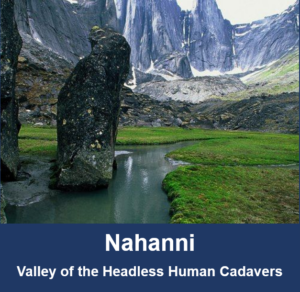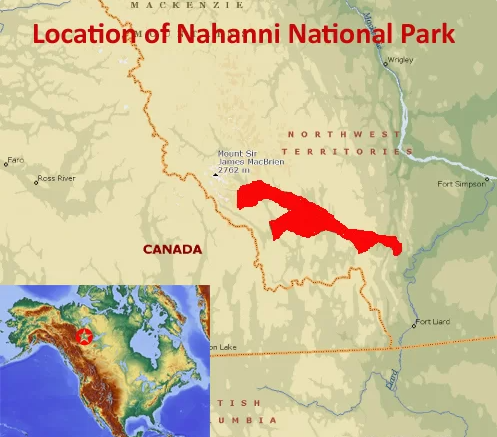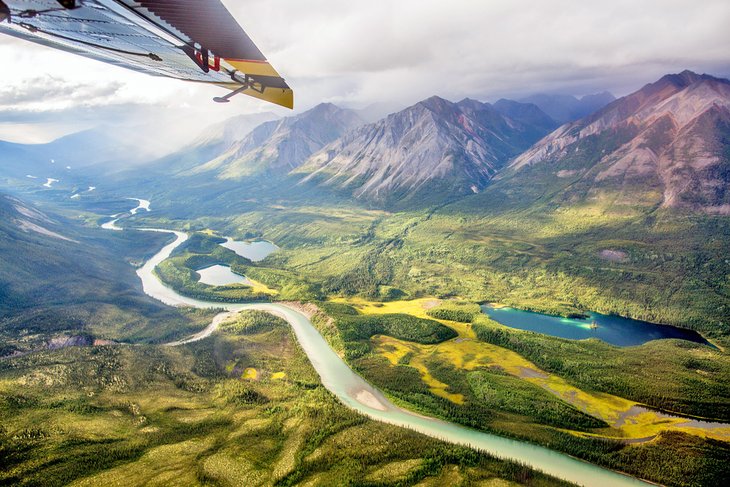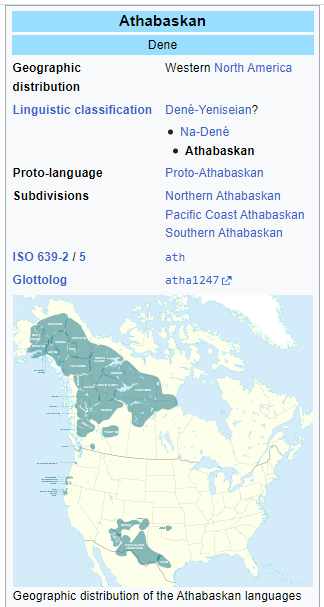 Nahanni National Park Reserve in Canada’s Northwest Territories is an extremely remote, phenomenally pristine, and breathtakingly beautiful place. It’s a UNESCO World Heritage Site that’s visited by only those with the means and stamina to survive the ordeal. But despite being named the Holy Grail of whitewater bucket-list experiences, the Nahanni River holds a hostile history. It’s known as the valley of the headless human cadavers.
Nahanni National Park Reserve in Canada’s Northwest Territories is an extremely remote, phenomenally pristine, and breathtakingly beautiful place. It’s a UNESCO World Heritage Site that’s visited by only those with the means and stamina to survive the ordeal. But despite being named the Holy Grail of whitewater bucket-list experiences, the Nahanni River holds a hostile history. It’s known as the valley of the headless human cadavers.
Since 1906 when the Nahanni River Valley was first explored by gold-seeking Europeans, 44 people have been reported as disappeared or found dead in the region. 6 of them were missing their heads and lying beside burned-out camps. There’s a local legend—some say supernatural suspicion—that explains this mystery. We’ll explore this phenomenon in a bit but, first, let’s look at the Nahanni itself.
To call the Nahanni remote is an understatement. The park covers 11,602 square miles and lies north of latitude 60 on the western side of Canada’s Arctic. Its boundary starts 300 miles from the nearest center of Yellowknife and, to put the distance in perspective, Nahanni is 3,570 crow-flying miles from downtown Manhattan.
Nahanni’s geology is utterly unique. It’s a blend of towering, icy-cold mountains and lush green river bottoms fueled by 250 smouldering hot-spring caverns creating mists of sulfuric air, giving the Nahanni valley an eerie, otherworld persona. From extreme winter cold dropping to fifty-plus below through to short, but warm and humid summers, the Nahanni is truly a place of extremes.
There are no human settlements in the Nahanni. The only access is regulated through permits issued by Parks Canada whose wardens act as oversight to the few who enter. Most visitors are wealthy adventurers who access the wilderness by floatplane and enjoy guided whitewater excursions along the 210-mile route that pounds through four canyons with 9,000-foot granite guardians. One stretch, at Virginia Falls, drops twice the height of Niagara with a nearly equal volume of water.
About 300 humans visit Nahanni per year but the park is teeming with life. According to Parks Canada, there are 42 mammal, 181 bird, 16 fish, 700 vascular plant, and 300 bryophyte lichen species recorded. Grizzly bears and wolf packs are the food chain’s apex… unless you consider the region’s winner of the most vicious creation award—the wolverine.
Speaking of humans, the Nahanni records 10,000 years of indigenous inhabitation. Human artifacts dating back to the age of the mastodon and the now-extinct bear dog have been excavated by archeologists. Clearly, the interaction between people and Nahanni’s nature has been ongoing for a long, long time.
Today, the Dene are the region’s First Nations people. They populate the southern and eastern areas outside the park but are the legal ancestorial owners of the land. However, according to Dene oral history, the Nahanni was once occupied by a small and separate tribe known as the Naha who mysteriously disappeared around the time of the white man’s arrival. Naha, in the Dene language, means “people from the Nahanni River Valley”.
European contact began in the late 1800s when Hudson’s Bay Company fur traders set up posts along the Mackenzie River which lies to the east of Nahanni and to which the Nahanni waters flow on their journey to the Arctic Ocean. The fur trade flourished, and native-white contact continued throughout the Yukon Gold Rush of 1898 and onward.
It was inevitable that gold fever would boil over from the Yukon into the Northwest Territories. The lure of gold does something to the human psyche where normal people will do abnormal things. This is where our story of the valley of the headless human cadavers begins, and I’ll outline the 6 specific cases.
Brothers Frank and Willie McLeod — In the summer of 1906, two Scottish brothers from Fort Liard ventured into the Nahanni valley in search of gold. They never returned. A 1908 search party found the pair deceased in a burned-out camp. The bodies were skeletonized and both their heads were gone. Today, the camp’s river tributary junction that runs into the Nahanni River is called Headless Creek, and the localized area is Deadman’s Valley.
Martin Jorgenson — He attempted to become a permanent Nahanni Valley resident. In 1917, Jorgenson, who was a Swiss prospector, relocated from the Yukon and built a small cabin in Nahanni. That same year Jorgenson’s cabin was burned, and his headless body lay nearby.
“Yukon” Fisher — This man lost his head in 1927 near the spot that claimed the McLeod brothers. “Yukon” Fisher was a part-time gold prospector and a part-time outlaw. He was wanted by the Royal Canadian Mounted Police in the Yukon and had fled to the Nahanni. Also like the McLeods, Fisher was found decapitated in a burned camp.
Phil Powers — In 1931, Phil Powers became the fifth poor soul to become beheaded in the Nahanni. His campsite, too, was consumed by fire.
The Unidentified Headless Man — Although this man (suspected to have come from Ontario) was never named, he joined the list of headless cadavers of the Nahanni Valley. It was in 1945. The body was wrapped in a sleeping bag lying beside a burned tent.
A list of names and suspected murder victims goes on through the Valley of the Nahanni. Angus Hall, Joe Mulholland, Bill Epier, and Annie Laferte disappeared without a trace. Hall and Laferte left nothing, but the cabin shared by Mulholland and Epier was—you guessed it—burned to the ground.
So, what was behind all this burning and beheading? If you search the legends, you’ll find these explanations:
The Nahanni Valley Monster — This creature is Bigfoot-like, and it likes to behead and burn white men.
The Evil Spirit — It’s a weather spirit that’s said to haunt the Nahanni, making its presence known with otherworldly shrieks on cold nights.
Giants — It’s also said that a race of Giants inhabit the Nahanni and cook their meals in Rabbitkettle Hotsprings.
Prehistoric Creatures — Native hunters and trappers speak of elders describing creatures that match known prehistoric animals like mastodons and bear dogs.
The Waheela — This is a huge, wolf-like being linked to deaths in Nahanni Valley.
The Nuk-Luk — Picture a short, bearded man who is half-naked and carrying a huge club.
Naha: The vanished tribe.
Dene oral history tells of a sub-tribe called the Naha (who were similar to the Dene and who spoke the same language) that lived in the Nahanni mountains, descending down to the valley floor to make war on trespassers. The Dene were fearful of the Naha and steered clear of the upper and central Nahanni region to avoid confrontation. The story goes that the Naha were a small band of maybe a dozen individuals that mysteriously disappeared in the mid-twentieth century.
Some Dene claim the Naha returned to the land where both tribes have connections, somewhere in the southwest United States. There may be some truth to this as Dene is an Athabaskan language and is linguistically similar to the Navajo and Apache dialects. To use the crow-fly measurement, the distance between the Nahanni and the Navajo/Apache lands is approximately 2400 miles—hardly a big deal by 1950 and an age of public transit.
But a more likely scenario is this. The Naha, a small group, occupied the upper and central regions of Nahanni. They were fiercely protective of their lands and not tolerant of invaders—not the Dene and certainly not the white gold seekers. It makes sense that these Naha warriors would eliminate threats to their land and their livelihood. Killing intruders, cutting off their heads, and burning their possessions would certainly send a “Keep Out” message. Eventually, a fight between intruding whites and the Naha wiped out the indigenous folks.
No, I can’t buy into the monster, the evil spirits, the giants, prehistoric creatures, the Waheela, the Nuk-Luk, or the weather theories. Supernatural entities and harsh climates cannot behead bodies and burn down cabins. In my opinion, it was the Naha who caused the headless human cadavers and, ultimately, it cost them their lives.





